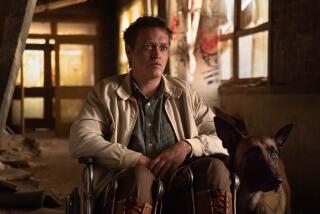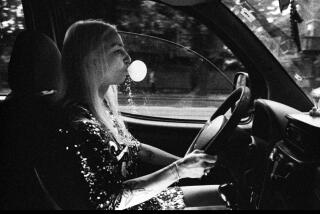Today’s film characters may be unlikable, but they’re not unworthy
These days, it seems as if the collective voice of moviegoers echoes the Taylor Swift lament “Why you gotta be so mean?”
And for once they’re not talking about me or my fellow critics.
The discontent and, in some cases, the disdain is directed at some of our most delightful actors, beloved ones such as Meryl Streep, Julia Roberts, Cate Blanchett and Leonardo DiCaprio to start. Many more of the acclaimed — John Goodman, Jonah Hill, Carey Mulligan, Michael Fassbender, Bruce Dern and Sarah Paulson among them — have been implicated. Even Tom Hanks, Emma Thompson and Judi Dench are getting their share of the recriminations.
None of which comes close to the mess poor Oscar Isaac finds himself in. What should have been a breakout turn as the star of the latest Coen brothers’ film, “Inside Llewyn Davis,” has turned into a nasty — and uncalled for — public rebuke. Most critics love the work. Audiences by and large do not, some coming to that conclusion merely from seeing the trailer. A pity.
PHOTOS: Winter movie sneaks 2014
The directors — Martin Scorsese, Joel and Ethan Coen, Alexander Payne, John Wells and others — are feeling the heat too. But the director’s chair is not so clearly in the line of ire. Scorsese, at least, has been trying to make the most of the controversy about the ill-mannered “Wolf of Wall Street,” confronting it to spark a conversation and drawing a bigger and more forgiving audience as a result.
It’s not the actors and filmmakers themselves fanning the flames but the characters — a royal rash of unlikables appearing in edgy stories that have a dark heart and dark humor. Whether it will become an age or an era — or just a spiking fever — is yet to be seen, though Angelina Jolie is already promising pure evil in May’s “Maleficent,” a remake of “Sleeping Beauty.”
I am hopeful the pique persists. For inside the most irritating and irascible characters that Hollywood’s top-flight talent has undertaken to portray is also some of the finest work we’ve seen on screen in years. Instead of irritation, the idea that films are doing such an excellent job of exposing so many baser qualities should be applauded. I take heart that so many made it onto the Academy Awards short list.
The unlikables were not always such anomalies. Alfred Hitchcock and Orson Welles certainly felt no need to soften their blows. A few decades later, uncomfortably defining work was being done in films such as “Midnight Cowboy,” with Dustin Hoffman’s gritty, needy lowlife Ratso, Robert De Niro in “Taxi Driver,” and Marlon Brando and Al Pacino in “The Godfather.”
BEST MOVIES OF 2013: Turan | Sharkey | Olsen
Meanwhile, TV has not simply embraced but become entrenched with antiheroics — “The Sopranos,” “Breaking Bad,” “The Following,” “The Blacklist,” “House of Cards” and on and on. Movie storytelling, on the other hand, settled into the notion of success. Triumph against the odds – from sports to love and life — have ruled, overruled. Occasionally a disruptor would blow through — “There Will Be Blood” and “No Country for Old Men” come to mind. What distinguishes the recent trend is the way filmmakers and actors are breaking out of the rut en masse.
The changing mood represents risk — real creative and career risk. Taken by the established, the entrenched and the rising alike, it could well be a game-changer if we allow it. For years, the grumble has been that Hollywood and filmmakers in general should take more chances. So why not redirect the outrage at the mediocre — there are plenty of choices on that front — and back the risk-takers even when it’s uncomfortable?
Let me take a moment to distinguish between a villain and a dislikable.
Movie villains will not only always be with us, frankly we can’t do without them. Where would the tension and conflict come from? Would the good guys even matter without the bad? A Batman without a Joker? A Valjean without a Javert? A 007 without, well, you get the point.
PHOTOS: Box office top 10 of 2013
So not villains in the traditional sense. Consider something more in the vein of DiCaprio’s audaciously awful Wall Street fleecer in “Wolf.” Baroquely amplifying the already tawdry tale, his Jordan Belfort wallows in money and depravity, the normally sweet Jonah Hill going dark right alongside him as his depraved partner, Donnie Azoff. If anything, DiCaprio is creating an excellent body of work out of bad. Last year, it was “Django Unchained.”
Consider the caustic matriarch Streep plays in “August: Osage County,” with her hellcat daughter in Roberts’ hands. Neither actress has been so biting, ever. Nor has director John Wells, whom I used to associate with “ER” but now tie to “August” and Showtime’s “Shameless,” cut from the same cloth.
Take Blanchett’s wonderfully insufferable turn in “Blue Jasmine.” Rarely has she or director Woody Allen been darker, laying bare the escalating emotional cost of Jasmine’s compromised marriage to the ultimate treachery it spawns. Dench’s “Philomena” is a bit of a pushy prig, as is Thompson’s PL Travers, and even Hanks can’t make Walt Disney all that likable. Meanwhile, “American Hustle’s” Jennifer Lawrence and Bradley Cooper are so outrageous they make Amy Adams and Christian Bale’s con artists look like heroes. Like “Wolf,” they are playing it for laughs — and succeeding grandly.
Irritants all. Exceptional also.
If you seek the merits and set aside expectations, it might help diffuse the distress. Watching Fassbender and Paulson as a sadistic slave owner and his vengefully jealous wife conjure up evil and hate in luridly brutal ways in “12 Years A Slave” is horrific, yet they also make the unimaginable imaginable.
PHOTOS: Behind the scenes of movies and TV
Less onerous but still prickly are Bruce Dern and June Squibb in Payne’s “Nebraska.” In these antagonistic spouses, so skillfully drawn by writer Bob Nelson, the film makes a statement about aging uncomfortably. Dern’s Woody is a cantankerous old coot, while Squibb’s Kate is a grating, emasculating harpy. While Woody remains dour, the sharp-tongued Kate is hysterically funny as she maligns the locals and herself in the process. In all the dissonance you also see resistance, one last grand stand against long years of failure, of misbegotten dreams, and who is without a few of those?
Let’s return to the film that has borne the brunt of the burn — “Inside Llewyn Davis.” It carries the double burden of being deemed by many moviegoers as a depressing tale as well as having an ungrateful, egomaniacal leading man. They seem to miss that Llewyn Davis is also a charming and obsessive artist, his brusqueness a barricade against deep emotional wounds.
Greenwich Village in the ‘60s was not an easy place. For aspiring singer-songwriters it was a caldron of disappointment. Yet a generation was defined by the failures like Davis as much as the successes, like Dylan. The Coens’ have rendered the time beautifully, Isaac has realized it remarkably, an acutely incisive performance of a man stumbling through his wasted ambition.
Are these protagonists likable? Not always. But these artists are reaching for greatness. It’s a risk. They are taking it. Shouldn’t we?
More to Read
Only good movies
Get the Indie Focus newsletter, Mark Olsen's weekly guide to the world of cinema.
You may occasionally receive promotional content from the Los Angeles Times.







